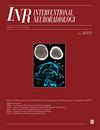Perfecting the pour: A novel co-axial technique with sequential injections for optimising cement delivery during sacroplasty
IF 1.7
4区 医学
Q3 Medicine
引用次数: 0
Abstract
BackgroundPercutaneous sacroplasty is an effective treatment for painful sacral fractures and tumours, however there is no accepted optimal technique for performing this procedure. This study investigated a novel approach to sacroplasty combining co-axial sacral access, sequential cement injections and hypothermic cement manipulation to improve cement delivery.MethodsThis retrospective study analysed 11 patients who underwent co-axial sacroplasty between April 2023 and March 2024 for treatment of painful insufficiency fractures ( n = 5) or malignant sacral tumours ( n = 6). All cases were performed using biplane fluoroscopy with conebeam CT navigation for planning and monitoring percutaneous access. Procedural details, technical outcomes, and clinical outcomes including Numerical Rating Scale (NRS) pain and analgesic utilisation on a six-point scale were analysed pre-procedure and at follow-up.ResultsTechnical success of was achieved in all cases using this technique. The mean injected cement volume was 20.5 ± 6.4 ml. Median pre-procedural NRS pain scores of 8 (IQR 7.25–8) significantly decreased to 0 (IQR, 0–0.25) at follow-up ( p <.01). The median preprocedural analgesic utilisation score reduced from 3 (IQR, 2–3) to 0 (IQR, 0–2.5) at follow-up ( p <.01). Cement leakage occurred during two cases without associated adverse clinical sequelae. There were no major adverse events.ConclusionCo-axial sequential injection sacroplasty is a safe and effective technique which allows facilitates controlled delivery of cement. Improved control of cement delivery, including around high-risk structures for cement leakage, offers a potential safety advantage over conventional sacroplasty techniques. Further research comparing technical and clinical outcomes to conventional techniques is warranted.完美浇注:骶骨成形术中优化骨水泥输送的新型同轴顺序注射技术
背景经皮骶骨成形术是治疗疼痛性骶骨骨折和肿瘤的有效方法,但目前尚无公认的最佳手术技术。这项回顾性研究分析了2023年4月至2024年3月期间接受同轴骶骨成形术治疗疼痛性不全骨折(5例)或恶性骶骨肿瘤(6例)的11名患者。所有病例均使用双平面透视和锥形束 CT 导航来规划和监控经皮入路。对术前和随访时的手术细节、技术结果和临床结果(包括数字评分量表(NRS)疼痛和镇痛剂使用情况)进行了分析。平均骨水泥注射量为 20.5 ± 6.4 毫升。术前NRS疼痛评分中位数为8(IQR为7.25-8),随访时明显降低至0(IQR为0-0.25)(p <.01)。术前镇痛剂使用量的中位数从 3(IQR,2-3)分降至随访时的 0(IQR,0-2.5)分(p <.01)。有两个病例发生了骨水泥渗漏,但没有相关的不良临床后遗症。结论同轴顺序注射骶骨成形术是一种安全有效的技术,有利于控制骨水泥的输送。与传统的骶骨成形术相比,该技术改进了对骨水泥输送的控制,包括对骨水泥渗漏高风险结构周围的控制,具有潜在的安全优势。与传统技术相比,该技术的技术和临床效果值得进一步研究比较。
本文章由计算机程序翻译,如有差异,请以英文原文为准。
求助全文
约1分钟内获得全文
求助全文
来源期刊
CiteScore
2.80
自引率
11.80%
发文量
192
审稿时长
6-12 weeks
期刊介绍:
Interventional Neuroradiology (INR) is a peer-reviewed clinical practice journal documenting the current state of interventional neuroradiology worldwide. INR publishes original clinical observations, descriptions of new techniques or procedures, case reports, and articles on the ethical and social aspects of related health care. Original research published in INR is related to the practice of interventional neuroradiology...

 求助内容:
求助内容: 应助结果提醒方式:
应助结果提醒方式:


